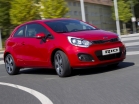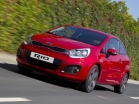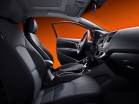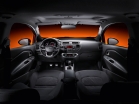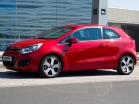Test drive Kia Rio 3 doors since 2012 hatchback
On a foreign land
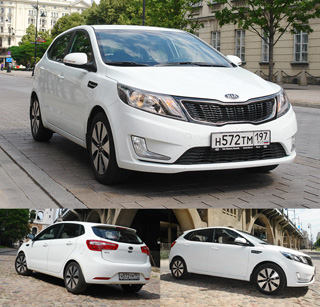 We experience the Russian Kia Rio European roads.
We experience the Russian Kia Rio European roads. This summer, the motor decided to drive through Belarus and Poland to Germany on Kia Rio hatchback to find out how a budget car developed specifically for Russia behaves on unusual European roads.
The result of our run: it is more than 4,500 kilometers of run and 58 hours spent by Kia Rio in ten days. The trip route was built around Warsaw one of the points last summer Euro 2012, which was probably visited by thousands of Russian fans. And many of them arrived in Poland in their own cars.
Travel route
1. Moscow Warsaw: 1255 km
2. Warsaw Wroclaw Dresden: 624 km
3. Dresden Warsaw: 682 km
4. Warsaw Gdansk: 378 km
5. Gdansk Warsaw: 378 km
6. Warsaw Moscow: 1255 km
Total: 4572 kilometers
Kia Rio can be considered a truly folk car. In Russia, Rio confidently holds in third place in sales: from January to August, this model diverged 56,425 copies. True, statistics do not share Rio according to the type of body. Both more common sedans and hatchbacks, which are produced and sold only from March in our country, come here.
We had a hatchback. Almost new, with a 123-horsepower 1.6 engine and an automatic machine, with a mileage of a little more than 300 kilometers, in the maximum configuration of Premium for 669 thousand rubles. Of course, such a price is already hard to call Rio folk, but do not forget that the initial bar for hatchback with a motor 1.6 on the handle is set as much as 120 thousand rubles lower. And for a surcharge, the client receives (in addition to automatic transmission) a number of options that are not available in less expensive trim levels: 16-inch cast discs, a chrome-glossy radiator grille, an optimal dashboard, skin-sheated steering wheel and automatic transmission lever, and finishing for piano varnish The central console, side pillows and safety curtains, ESP stabilization system, Smartkey, climate control, wheel heating, Bluetooth interface and rear parking sensors.
The set, of course, is not entirely characteristic of a budget foreign car. And it is quite strange that it cannot be supplemented with such useful things as rain and light sensors or a cruise control.

Kia Rio in the Premium configuration is equipped with a non -clock access system. If there is a chip key in the pocket, the car is opened by pressing a special key on the door handle, and starts with a button on the instrument panel
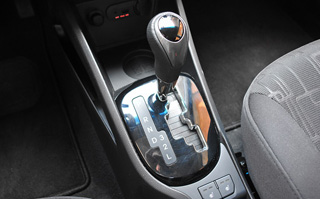
The automatic machine for Kia Rio is still four -speed, with breathtakingly long gears. For good acceleration on overtaking, he has to first switch to second gear, and then hastily stick a third

The optimal panel of the devices, which completely goes out after the ignition is turned off, is read perfectly. But this is the prerogative of the expensive version of Premium
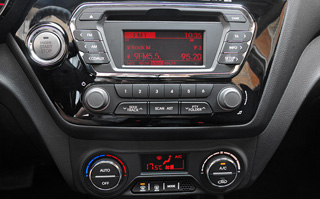
Blocks of music and myrilmata are combined conveniently and do not require any addiction. Via Bluetooth you can connect a player or mobile phone
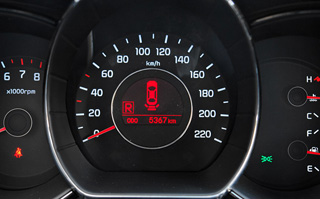
Parctronics in Rio not only gives sound signals, but also has a graphic display on the screen panel screen
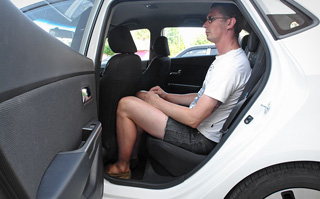
With a height of about 180 centimeters, it is quite possible to sit down behind yourself. The knees only slightly touch the back, but if the passenger is higher, then the head will support the ceiling
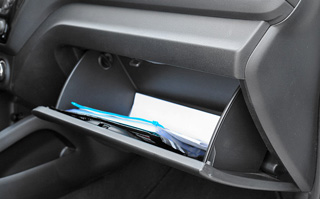
A4 papers folded in half are placed in the glove box
Cruise control would be very useful on the Moscow Brest highway. This is a road of excellent quality, which is closer to Belarus and completely turns into an almost deserted straight autobahn. It is difficult to evaluate the dynamics and handling of Rio here the car is just going all the time at the selected speed. But noise insulation on the highway seems good, and 150 kilometers per hour can still be calmly talking with a fellow traveler. And the chairs, although they have a simple shape, a minimum set of adjustments and not a very long pillow, distribute the loads evenly and prevent the body from getting tired on the long journey.
The monotonous uniformity of the M1 highway provokes to exceeding speed. And although the restriction on the Belarusian part is 120 kilometers per hour, I still want to push. But remember about the video recording cameras, which from July 1, 2012 are no longer in test mode, as before.
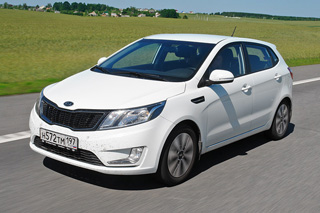
The motor does not call for violating the SDA, but the M1 highway is so good that sometimes it is very difficult to stay within the established framework, especially at the night when the traffic cops are sleeping. In addition, it was interesting to find out how much fuel consumes Rio at such speeds. The result of 10.3 liters per hundred. It is quite normal, given the unwell of the car and high average speed.
AIDS CAMERS on the M1 highway
On the federal highway M1 Moscow-Brest, many video recording cameras were installed. On the Russian part of the road, console-designed cameras are most often found that shoot a car in the forehead. The exact description of the location of the cameras in Russia could not be found. We counted about 10-12 pieces. All of them are clearly visible, although information signs are not established before them.
But on the Belarusian part of the M1, 15 video recording devices have been officially installed, which are configured and work since July 1, 2012. Speed \u200b\u200brestriction on M1 120 or 100 kilometers per hour. But it is worth remembering that the Belarusian radars look a little different, located at the height of the car, mainly shoot in the back and are often not indicated by special signs.
Here is a list of current-existing photo and video recording cameras (mileage from Brest):
150th km (this is a denouement with an expensive p6)
287th km (near the village of Sloboda)
297th km (turn to the village of Kolosovo)
306th km (turn on the bridle)
314th km (near the village of Vishnevka)
322nd km (near Dzerzhinsk)
368th km (near the crap)
388th km (denouement with the road m2)
At customs in Brest, problems arise, as a rule, on weekends, when many Belarusians leave for Poland for shopping. On ordinary days, the transition takes no more than an hour. In our case, the process of crossing the border took only 40 minutes.
After the chic Belarusian autobahn on the Polish roads narrow and loaded from Kia Rio, all of its 123 horsepower are already required to make overtaking in rare places permitted for this. The machine has to switch to second gear for effective acceleration, and then, in the process of overtaking, quickly draining into the limiter, go to the third.
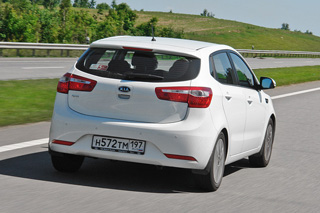
The speed restrictions on the Belarusian part of the M1: 100 kilometers per hour for trucks and 120 kilometers per hour for cars. But Belarusian police officers look through their fingers to excess speed up to 20 kilometers per hour.
However, there is nowhere to overtake: continuous settlements, many signs of overtaking are prohibited and, as a result, the average speed on the Polish part of the run fell to a very modest 70, or even 60 kilometers per hour. And in those places where I really want to spur, the Polish traffic cop may well be in the bushes.
It takes about 3.5-4 hours to overcome 200 kilometers to Warsaw. But fuel consumption at the entrance to Europe immediately falls. In such conditions of movement, despite the frequent overtaking, when the Kia automaton takes the motor for high speeds, Rio consumed about 7.6-8 liters of gasoline. But do not forget that if in Belarus a liter of the 95th costs about three rubles cheaper than in Moscow (27 rubles versus 30), then in Poland a liter of gasoline Super costs an average of 58-59 rubles. Therefore, before the Polish border, it is better to refuel to the eyeballs.
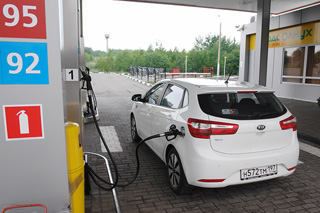
In the city stream of Warsaw, Rio dynamics are enough. Even in the third gear, the hatchback accelerates lively. And if desired, you can block the machine at the second stage. And there are already 123 RIO forces more than many Polish small -leafers. But the advantages of a rather comfortable suspension come to the fore in the city, which allows you to not very much slow down even in broken areas.
Anyone who drove this summer to the European Football Championship on a car on a route from Warsaw to Wroclaw was probably a witness to the extensive construction of a new highway, and at the same time a hostage to a temporary organization at a maximum speed of 70 kilometers per hour. Only one side of the autobahn works, divided by a continuous line into two stripes, so 350 kilometers to the monster can go for six hours, or even more. True, with a record low fuel consumption for Kia Rio 7.1 liters per hundred. However, a year later, these same 350 kilometers can be driven almost three times faster.
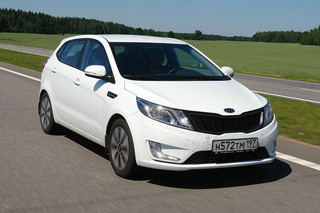
On the streets of the Old Wroclaw with frequent tram rails and the interspersed of paving stones, we more than once with a good word recalled the smoothness of the Rio course. Although the car reads all minor irregularities, it almost does not disturb the passengers with blows, and larger potholes are so gently that you soon stop paying attention to the quality of the coating.
The Rio suspension is easily given the joints of the bridges, and lying policemen, and broken roads. The level of comfort is very good for a car of class V. In addition, in the parking lot, you can also call on a curb, and the clearance of Rio has quite serious 160 millimeters.
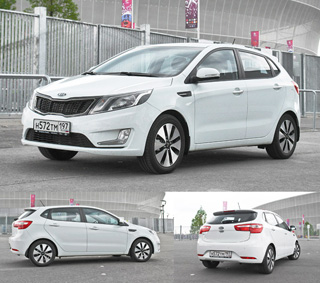
The next point of our route Dresden, the most beautiful city of East Germany. Only about 270 kilometers along the A4 A4, which, barely crossing the Polish-German border, almost immediately rests on Dresden, will have to drive from Vroclav. Only good can be said about the A4 highway: its Polish part differs from the German only by the presence of a speed limit of 130 kilometers per hour, which no longer acts on the side of Germany.
And this means, Long live the unlimited autobahns of Germany! It's nice to realize that no one will fine you for excess speed. Here we managed to disperse Rio to passport 178 kilometers per hour of maximum wipes painlessly and impunity. However, the overall noise level at such a speed grows strongly. A motor is soloed, which constantly has to work at high speeds, and Kumho Solus tires. But there are few aerodynamic noises.
But the consumption of expensive German gasoline at a speed of about 170 increases to indecent 13 liters per 100 kilometers. A regime completely unbearable for long trips, because a small 43-liter gas tank ends in three hours! And Rio does not give pleasure from movement in such modes. The steering wheel, which is not devoid of feedback in ordinary modes, becomes much less sensitive at high speeds, zero is greatly smeared and there is a feeling of not complete control over the machine.
Despite the fact that in fact, there are no speed restrictions on Germany, sometimes they are still found. As there are police officers who often patrol on cars without identification marks, dressed on a civilian. You can easily run into a fine, which the crew will most likely offer a credit card on the spot.
Parking in the center of Dresden is a little more expensive than in Warsaw 18 euros (about 700 rubles) per day. But in two days of driving along Dresden (one of them a day off), Rio showed a very humble fuel consumption of 7.3 liters per hundred kilometers. However, it is not surprising: in Germany, a very thoughtful organization of movement, and there are very few cars on Sunday. It is unlikely that it will be possible to repeat this in Moscow or St. Petersburg.

On the way back to Warsaw, to pass the unfinished section from Wroclaw to the capital, I had to make a small hook (682 kilometers instead of 617) through Frankfurt and Poznan.
The E30 highway, which had to go towards Warsaw, is a Polish autobahn: wide, even, but with a speed limit of 130 kilometers per hour and the first payment points on our way. In total, for almost 500 kilometers, which the E30 passes through the territory of Poland, had to be laid out about 700 rubles. But the travel time was only about six hours, in return for quite possible nine hours through the Wroclaw.
If before that we traveled together plus three weighty bags in the trunk, then two more comrades with their luggages joined us on the road from Dresden to Warsaw. They settled quite comfortably, despite the fact that the growth of any of the front passengers is at least 179 centimeters. Two more bags lay in the trunk, while I didn’t even have to clean the shelf. Of course, the trunk of the hatchback for as much as 111 liters is less than the trunk of the sedan, but it does not seem small at all. And given the possibility of loading to the top, he and the sedan rejoice.

The volume of the trunk of the Kia Rio hatchback is 389 liters, which is 111 liters less than that of the same sedan. Nevertheless, three large road bags easily stand in one row, and the same room remains above them.
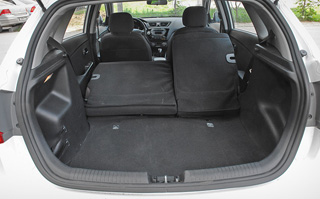
You can fold the back of the rear sofa (in a ratio of 2: 3), thereby increasing the useful volume of more than three times. But the flat floor does not work.
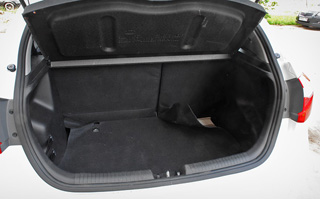
The floor of the luggage compartment is covered with a cheap rug that constantly frowns.
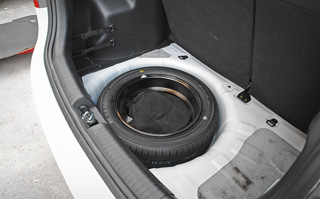
But under it is a full -size reserve (195/55 R16) and a minimum set of tools.
This is not to say that with such a rather serious load, Kia Rio has lost a lot in dynamics or handling. Of course, he became less mobile, but there is practically nowhere to feel this on the autobahn. If only when moving into a protracted rise, when the speed begins to fall, despite the gase pounded on the floor.
The loaded suspension on the straight line has become supercomfort, very gently and smoothly smoothing fluctuations. But on the interchanges, the angle of the roll increased, which is understandable: the mass increased, the center of gravity has shifted. But the main thing is that all these 700 kilometers were comfortable for all four passengers.
Two- and three-lane roads, now and then fell on our route, again and again forced to regret that our car was equipped with automatic transmission, and not honest mechanics. Up to 100 kilometers per hour, a car with a machine gun accelerates for a second slower than its mechanical counterpart, and in terms of elasticity it noticeably loses to it.
So if you decide to buy Kia Rio for active driving, take the car on the handle. Such a car has a decent accelerated dynamics, is perceived as more powerful, and overtaking it is much easier.
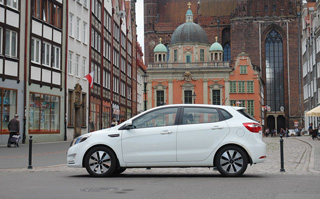
Kia Rio, against the backdrop of the largest Gothic Cathedral in Eastern Europe, Mariaste Church (the Ascension Church of the Blessed Virgin Mary). The construction of the temple lasted from 1343 to 1502
On the narrow streets of old European cities, you pay attention to the good visibility of Kia Rio. The area of \u200b\u200bglazing in the car is large, and the mirrors provide a sufficient review back. But sometimes when moving in reversing, I still want the racks to be a little more, and the glass of the fifth door is slightly larger. Well, at least rear parking sensors work properly.
How does the budget Rio behave on the roads, which in Russia you will not meet on serpentines? We checked. It turned out that looking for refined handling in a folk car is empty. Kia has no. As, however, there are no frank flaws that would spoil the impression of the car. Rio is not quite a mattress, although it follows the wheel with some lazy. The suspension cannot be called too soft, but the rolls in the turns could be less.
According to rio, RIO’s sled settings are an arithmetic mean, with some look at a calm driver who is much more important than comfort than the acuteness of management.
In total, at the wheel of Rio we spent almost two and a half days! It is no wonder that for such a long time you begin to pay special attention to the quality of the interior and thoughtfulness of ergonomics. The Rio salon looks modern, but the materials are, of course, rustic, and leather seats, for example, cannot be ordered in principle. The lighting of the devices does not have enough brightness in sunny weather, and the piano varnish of the front panel is quickly covered with fingers.
Nevertheless, the interior is assembled with high quality, no creaks and crickets. There are multi -caliber containers and a special compartment for a mobile phone. And one more important feature: despite the red backlight, nothing in the Kia Rio controls or controls is annoying. The former are well read, and the latter are easily accessible.
Interior
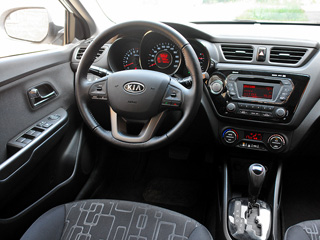
The interior of Kia Rio looks quite modern and does not give out the budgets of the car. Plastic is different in stiffness, but the same in texture. Convenient multifunctional steering wheel, neat upholstery of doors and seats, skin trimming the visor panel, lamb and lever automatic transmission.
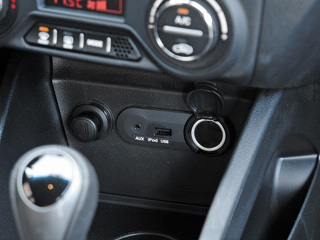
Внизу, под блоком микроклимата, за селектором автомата расположены две 12-вольтовые розетки. В одной может подзаряжаться, например, телефон, в другой навигация. Здесь же входы AUX и USB. Все это пригодилось в дальней дороге.
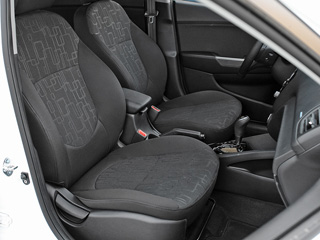
Водительское кресло регулируется не только продольно, но еще и по высоте. Сиденья, обитые специальной, не маркой тканью, простые по форме, но довольно удобные. Вот только хотелось бы большей плотности и более акцентированной боковой поддержки.
Готовы ли мы ответить после этого пробега на вопрос, в чем причина такой популярности Kia Rio в России? Yes. Секрет успеха в балансе потребительских качеств Рио. Нельзя сказать, что Рио в чем-то невероятно хорош. Но в то же время он нигде и не провалился.
Rio не спортсмен, но он и не размазня. Его подвеска позволяет активно ехать даже по неровным российским дорогам и при этом не сильно терять в комфорте. В спокойном же ритме плавность хода и вовсе великолепна, а цифры расхода топлива в Европе падают до вполне адекватных для такого автомобиля 7-8 литров на 100 километров. Пусть в России расход подрастет где-то на литр, но в этом будут виноваты лишь наши условия движения.
Rio с автоматом практичный в пробках, но слишком уж нерасторопный для активного водителя автомобиль. Четыре ступени автоматической трансмиссии позавчерашний день. Машина с механической трансмиссией вот более подходящий вариант. Рио становится намного живее, расход падает, да и комплектацию можно подобрать победнее и подешевле.
Но в любой модификации у Рио будет достаточно вместительный для автомобиля класса В салон, хорошая отделка, стильный интерьер, мощный мотор, дорожный просвет в 160 миллиметров и специальные доработки для России (защита картера, аккумулятор увеличенной емкости, брызговики, более вместительный бачок омывателя, антикоррозийная обработка кузова), которые доступны уже в базовой комплектации Comfort за 479 900 рублей (с двигателем 1.4). Не так уж и мало за такие деньги.
Почем бензин?
Средняя цена на 95-ый бензин (марки Super) в России, Белоруссии, Польше и Германии:
Россия 29-31 рубль
Белоруссия 26-28 рублей
Польша 58-59 рублей
Германия 63-65 рублей
Пробег в цифрах
Пробег с начала теста 4572 километров
Время в пути 58 часов
Средняя скорость по маршруту 82 километра в час
Средний расход топлива 9,1 литра на 100 километров
Средняя стоимость топлива по маршруту 42,1 рубля
Общий бюджет путешествия
Затраты на топливо около (6553 + 10947) 17 500 рублей
Платные дороги около 700 рублей
Green Card insurance about 1,400 rubles
Paid parking about 4000 rubles
Total about 23,600 rubles
Technical characteristics Kia Rio
Engine Type gasoline R4
Working volume 1591 cm
Max. Power, L.S./rpm 123/6300
Max. moment, nm/rpm 155/4200
Type of drive front
Transmission 4 -step automatic transmission
Front suspension Independent McPherson
The rear suspension is semi -dependent
Brakes Disc ventilated in front and discs behind
Dimensions DHSHHV, mm 4120x1700x 1470
Wheel base, mm 2570
Equipped mass, kg 1145
Max. Speed, km/hour 178
Acceleration 0 100 km/h, from 11.3
Fuel consumption of the combuster. , l/100 km 6.5
Emissions CO2, g/km 389
Fuel tank volume, l 43
Summer of the luggage compartment, l 389
Tire size 195/55 r16
Price, rubles 669 000
Source: Motor magazine [September 2012]

